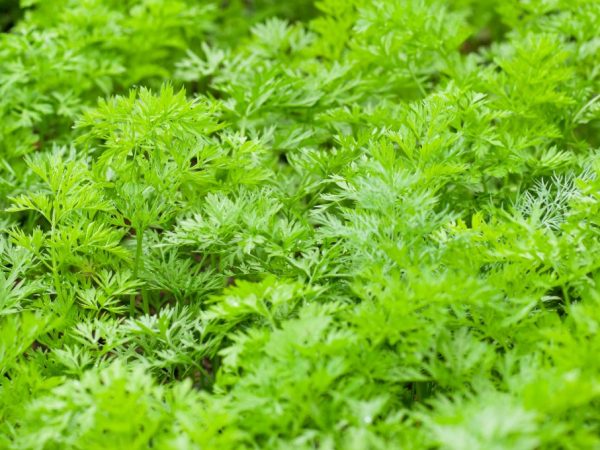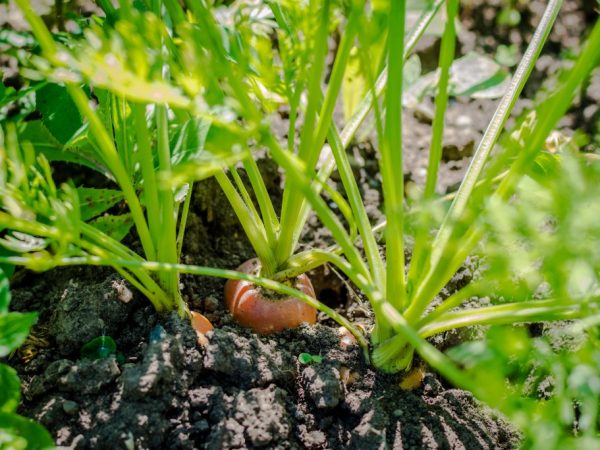Top dressing of carrots in June
Top dressing of carrots in June plays an important role in the formation of root crops. The quality of the crop, its characteristics and quantity depend on the correctness of actions. For the entire period of growth, the plants are fed 4 times. Three of them are produced in June and are the most important.

Top dressing of carrots in June
Features of June dressings
Among the features of cultivation, the need for the timely introduction of minerals and abundant regular watering is distinguished. Feeding carrots in June should be given maximum attention, because:
- During the period of active growth, plants require nitrogen. This substance is found in abundance in organic fertilizers: cow dung, poultry droppings, infusion of weeds with yeast, as well as in chemicals: nitric saltpeter or urea.
- During the growing season, root crops need potash fertilizers. This trace element is found in potassium nitrate, potassium permanganate and wood ash.
- Together with the above two elements, the root crop needs phosphorus. Superphosphate, bone meal and nitrophoska contain a large amount of this element, so their use in carrot farming is mandatory.
A skilful and correct combination of the microelements listed above can improve the growth rates of root crops. Due to the balance of nutrients in the soil, the harvested crop is well stored, and the fruits remain juicy, aromatic and sweet for a long time.
The best formulations and fertilizers

Choose the right and convenient fertilizers for you
To feed the carrots in June, and with it the beets, will turn out with the help of organic substances or using fertilizers produced in the chemical industry. The latter are available in the form of solutions, granules or powders.
Among the ready-made mineral complexes of high concentration, the most often used are the compositions made by the concerns "Agricola", "Gera", "Fasco" or "Agrovita". They do not have a special name, and the packaging says "For feeding carrots and beets."
First feeding
The first feeding of root crops, including beets, is done when the plant releases the second pair of true leaves. Root crops are fertilized with the following composition:
- 15 g of urea;
- 20 g of potassium nitrate;
- 15 g double superphosphate.
The resulting amount of minerals is dissolved in 10 liters of warm water. The solution is watered between the rows, avoiding the ingress of liquid on the leaves.
Subsequent feeding
The second fertilization is carried out 10 days after the first.
It is also root. Fertilizer is prepared from half the norm of the substances listed above, or any complex preparation is used in which phosphorus, potassium and nitrogen are present. The quantity is determined according to the instructions.
The third fertilization is carried out 7-10 days after the second. If the first soil treatment was carried out in early June, it will be correct to feed the plants a third time in late June or early July.This time potash and phosphorus fertilizers are applied. If there is no shortage of deciduous mass, nitrogen fertilizer is not applied at this stage.
Signs of mineral deficiency
To understand which of the minerals the plant needs the most, turn to the signs of mineral deficiency. The most common manifestations are:
- The lack of potassium is manifested by the defeat of the tops of fungal diseases and pests. Due to the low concentration of this mineral, root crops react to a lack of moisture and stop growing during these periods. A characteristic sign of a lack of potash fertilizers is the formation of a tight skin and a thickening of the core.
- Nitrogen deficiency is manifested by yellowing, curling and dropping of the tops. Under the ground at this time, the fruit grows deeper and is overgrown with a large number of fibrous roots. Also, the roots become soft and lose color, and they also produce little carotene.
- A small amount of phosphorus leads to the fact that the root crop is not able to form the correct root system, so you cannot count on a good harvest.
The consequences of a lack of minerals or their incorrect, irrational introduction into the soil in the beds with carrots are:
- poor preservation of the crop;
- small fruits;
- bitterness in taste;
- woody core;
- root crops with multiple roots and irregular shape.
Conclusion
Feeding carrots in June is essential. During this period, the roots consume the maximum amount of nutrients and form the root system.
The most important minerals for the plant during this period of development are potassium, phosphorus and nitrogen. The use of balanced compositions and ready-made complexes of microelements will make it possible to replenish the lack of substances in the soil and provide root crops with the necessary nutrition.


